Reviewed by Glenn Erickson
Scream Factory went straight for the prime horror content in its new licensing deal with MGM. Last Fall they released The Vincent Price Collection, a dazzling compilation of some of American-International Pictures' best releases in their most profitable decade. A winning combination came together in 1960's The Fall of the House of Usher -- filmmaker Roger Corman made the leap from drive-in fare to a full-fledged minor "A" picture filmed in CinemaScope and color, with a genuine movie star who whole-heartedly embraced the horror genre. As Vincent Price's fortunes as a character actor faded in the '50s, his formidable talents -- an imposing stature, a cultured temperament, a terrific way with dialogue -- paid off when he became a headliner in scream pictures. Price's voice alone had the power to induce amusing shudders, as was shown with just one dialogue line in Abbott and Costello Meet Frankenstein. Perhaps the first full preview of his personal brand of velvety menace was in House of Wax. More 'creepshow' ventures led him to exceptional work in a memorable pair of William Castle chillers. Did anyone else realize what a gold mine Vincent Price represented? Who else could carry off (and sanitize) the arcane dialogue of costume pictures about sorcerers and necrophiles? Apparently only horror fans and directors like Roger Corman realized that Price was a pre-sold name with kids -- his was the face with the knowing smirk, that scared people to death in House on Haunted Hill.
A.I.P.'s Sam Arkoff had a way of buying films and filmmakers at bargain rates and never looking back. But Roger Corman's early pictures had launched the company. His track record was so good that A.I.P. rolled the dice on Edgar Allan Poe, a writer of poems that kids were forced to recite in high school. The gambit was so successful that the company spent the next ten years figuring ways of generating more Poe pictures. If a property or coproduction had a horror element and could be bookended by three lines of Poe verse, it qualified as a Poe release.
Scream Factory's Blu-ray set gives fans terrific transfers of six Vincent Price attractions and a generous helping of extras, some repeated from older MGM DVDs and others newly concocted. Four of the films are Roger Corman productions, with two fan favorites that originated with English filmmakers.
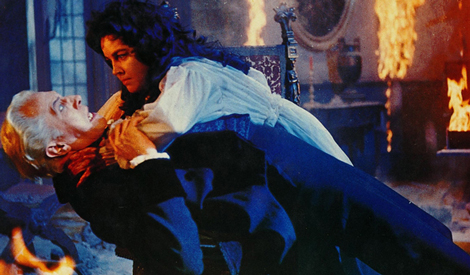
Corman's The Fall of the House of Usher has held up extremely well. It earned considerable industry respect for the director, who was previously dismissed as a maker of things with titles like Attack of the Crab Monsters. Although too young to see Usher, I remember staring at A.I.P.'s sensational poster, which showed figures descending a flight of stairs that crisscrossed the frame, with an open coffin at the bottom. Even the typeface for the lettering was creepy-looking. At eight I didn't even know who Frankenstein and Dracula were, so that poster was probably my first contact with horror movie iconography.
Forget the haste and occasional slipshod nature of his earlier efforts, as Corman maintains full control of the larger-scale production. While Les Baxter's romantic score indulges in effective haunted house riffs, Floyd Crosby's camera records Vincent Price as a strangely frail, white-haired victim of some strange malady of body and soul. Price makes us feel the concept of a man hypersensitive to every sensation -- touch, sound, light -- as if he were allergic to being alive. The film alludes to incest between Price's Roderick Usher and his sister Madeline (Myrna Fahey) without presenting it as 'shocking' content -- Roderick is twisted in other, secret ways that seem beyond our understanding. What other kinds of guilt is he hiding? The supposed hero (Mark Damon) is a real third wheel in the setup -- we can tell that his attempts to rescue Madeline from her 'unusual' home situation will come to nothing.
The movie is a bit over-lit, and I'd have to say that although Daniel Haller's sets are indeed elaborate for a small film, they still have that hasty "wild wall" design look. Yet Corman, Crosby, Haller and screenwriter Richard Matheson excel in the horror highlights. I'm not a fan of haunted house movies, but the trips to the crypt are excellent, as are the tinted dream sequences. Corman uses the wide screen to excellent effect when nobody notices that the corpse at a funeral is alive and twitching. Couple that with views of the house's crumbling exterior walls and a killer shot of Madeline's crazed eyes behind bloody hands, and The Fall of the House of Usher has at least ten permanent horror images to imprint into impressionable young minds.
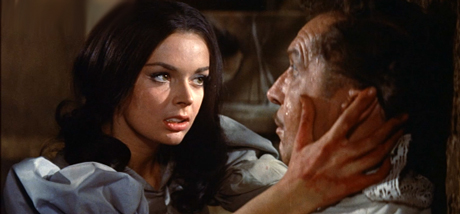
If House of Usher promised chills and thrills, Corman's 1961 Pit and the Pendulum delivers much more in the way of action, violence and barnstorming performances. By this time Vincent Price may already have been signed to a long-term A.I.P. contract. Richard Matheson extended Poe's terrifying short story (which is limited to the subjective experience of a victim caught in the torture pit) by grafting on a setup similar to Usher -- a handsome young man visits to find out what became of his sister. This time the setting is a castle in Spain. The budget was stretched to accommodate more impressive sets, special effects and two extra name stars. John Kerr manages to avoid ridicule in his Spanish costume, while newly minted horror queen Barbara Steele provides the spark of perfidy that ignites a burst of gruesome violence. Matheson's back story gives Vincent's Nicholas Medina a father whose hobby was maintaining a Torquemda-approved torture dungeon. Premature burial plays a big role as well, with Daniel Haller coming up with a nightmarish desiccated corpse for one quick, indelible flash image.
For supporting duty, Corman reaches into his loose company of acting associates and brings forth Anthony Carbone (Last Woman on Earth) and the lovely Luana Anders (Night Tide). This time out Matheson's script requires Vincent Price to begin as a disturbed widower, proceed to a state of guilty delirium, then go tutti-fruity nuts, and finally resolve as murderously deranged. Nicholas takes on the identity of his father, and with it a fanatic desire to get that torture chamber in operation again. Some say Price takes this characterization a bit too far, what with Nicholas alternating between infantile giddiness and (verbally eloquent) hyper-malice. Price certainly overpowers Barbara Steele's impressive turn as the wicked wife, Elizabeth. Steele's cat-like smile makes her face suddenly look twice as wide. Most of the beauties described by Edgar Allan Poe were virtuous but Steele's Elizabeth is so nasty that she can't stop gloating over Nicholas. She foolishly underestimates his ability to function while in a state of stark raving madness.
The finish is John Kerr's unpleasant appointment with the title contraption, which Corman works up into a major climax. That he has a "gotcha!" stinger left over for the fade-out (or ragged iris-out) shows excellent directorial control. Pit and the Pendulum is probably the Corman/Poe picture with the highest thrills-per-minute rating. I'd bet that even Alfred Hitchcock enjoyed its macabre final shot.
Once again Corman reserves his attention and resources for the important scenes in what was probably a very economical shoot. Les Baxter's music this time isn't so carefully scored to individual scenes, and just seems to meander in electronic echoes during the finale (where artwork on the walls of The Pit is reminiscent of old Corman title sequences}. There also isn't much in the way of a Spanish flavor to be had in the performances, which also detracts a bit; until he went to England, Corman's Poe films would continue to look like studio-bound budget productions, no matter how big Daniel Haller made the sets. Yet Corman's interpretation of Poe's violent story had a real edge (hmmm..) in 1961. If the 'school approved' author Poe weren't part of the picture, I have a hard time believing that the Production Code would have permitted such a detailed depiction of the Sadean pendulum in action. Two Poe pictures into his series, Roger Corman has two unqualified winners.
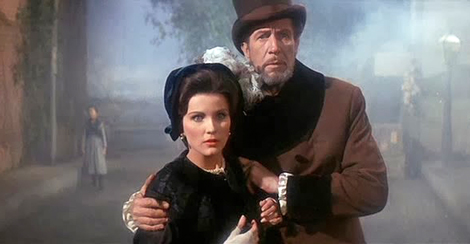
Perhaps Corman was already feeling that the Poe Horror Vein had been tapped out, as his next couple of pictures (with the exception of The Premature Burial) played mostly as comedies. All made enough money so the desire of A.I.P. was to keep grinding them out, as it was doing with its Beach Party movies. In 1964 Corman joined with Charles Beaumont, the writer of his courageous The Intruder to leave Poe behind and try out the untapped riches of cult horror author Howard Phillips Lovecraft.
Some sources including Corman have stated that The Haunted Palace bears a Poe title because the risk-averse marketers Sam Arkoff and James Nicholson eventually ran for cover. But Beaumont's final draft script is called The Haunted Palace and credits Lovecraft and Poe on the cover. Beaumont elaborates on Lovecraft's original The Case of Charles Dexter Ward, in which a Providence resident manages to resurrect his ancestor Joseph Curwen, a diabolical sorcerer who harks from the notorious town of Salem. The film brings in a romance (Ward has a beautiful bride, played by Debra Paget), gothic trappings (local girls hypnotically induced to serve as human sacrifices), and other Lovecraftian concepts. It's the first film to name-drop the Cthulhu Mythos. In yet another dungeon we find an unholy altar above what seems to be a portal to another dimension, a hellish underworld inhabited by Lovecraft's indescribably horrible Elder Demons.
Corman's adaptation makes Lovecraft's Dexter Ward look more or less like his other Poe pictures. The action takes place in a castle imported to America, and the villagers behave like the peons living in the shadow of Dracula's castle. They hate and fear the Curwen legacy, as the sorcerer's vile experiments have resulted in generations of bizarre mutations that roam the foggy town streets. Instead of resurrecting Curwen, Ward is simply possessed by him. This choice bypassses special effects requirements and giving Vincent Price the task of distinguishing the two men through acting alone.
Prominent in the cast is Lon Chaney Jr., as one of Curwen's necromancer colleagues. It may be Chaney's last worthy genre appearance, save for Jack Hill's Spider Baby. The movie neglects to tell us what becomes of Chaney and his cohorts, but it does show them trying several times to resurrect the rotted corpse of their female consort Hester Tillinghast (Cathie Merchant). Between Ms. Merchant and Debra Paget, The Haunted Palace is a feast of beauty. The rather large supporting cast has Elisha Cook Jr. playing with more Corman regulars, including Bruno VeSota, John Dierkes and Barboura Morris, and both Frank Maxwell and Leo Gordon from The Intruder.
The Haunted Palace has rich cinematography and apparently no daytime scenes at all. Ronald Stein's commanding music score is quite good, and a main theme that reminds fans of Brian Eno's main theme for David Lynch's Dune. The impressive title sequence contains the biggest blooper of the entire "Poe" cycle -- the famous author's name is misspelled.

Vincent Price fans looking for thematic strength tend to prefer 1964's The Masque of the Red Death, in which Corman and Price return to a completely sober, morbid reading of Poe. A famous script called Harrow Alley is said by some to be one of the best ever written, but it's never been filmed because no producer could be convinced that audiences would want to see a movie about a great plague. But Corman and his writers Charles Beaumont and R. Wright Campbell filled theaters with viewers willing to watch 'the red death' wipe out the entire feudal district ruled by the wicked Prince Prospero.
By 1964 A.I.P. had opened a London office to join the rush of American studios taking advantage of the Eady tax breaks and (possibly) less expensive filming environment. Roger Corman saw the move as a way of getting more value but also of giving his series of Poe adaptations a more polished look. He wisely opted for the up 'n' coming cinematographer Nicolas Roeg. Masque also surrounds Vincent Price with high-caliber British actors capable of bringing almost any fantasy to vivid life.
As in Poe's original, Prince Prospero responds to the plague by locking himself and his guests inside the castle walls and refusing shelter to the terrified peasants under his protection. Prospero invites the virginal Francesca (Jane Asher) to join him, as deflowering and disillusioning innocent girls is one of his favorite pastimes. Francesca thinks she's saving the life of her beloved Gino (David Weston) and her father (Nigel Green), but Prospero has no intention of keeping his promise: he commits evil deeds as a way of pleasing his master, Satan. Among Prospero's hangers-on, parasites and prisoners are the corrupt noble Alfredo (Patrick Magee), his concerned former mistress Juliana (Hazel Court) and Hop Toad and Esmerelda, midget performers for the court's amusement (Skip Martin & Verina Greenlaw).
Corman doesn't really find a new look, as his production designer Daniel Haller came along to put together the large-scale sets. Haller mixes and matches existing set flats, making Prospero's castle an eclectic jumble of styles. The talented Nicolas Roeg certainly delivers striking images, but most of the interior lighting is still high-key, giving the movie a curious flat look. The most surprising thing about the generic anamorphic "Colorscope" format is that even with Roeg behind the camera, Masque has the worst optics I've seen for a 'scope film. When Corman pans his the camera, some lenses make the sets looks as if they are oozing across the screen, stretching and shrinking in waves. Luckily, this only becomes distracting in a few wide pans.
That said, Corman achieves some of his most impressive effects. With her red hair and sorrowful eyes, Jane Asher is the picture of vulnerability as the peasant girl installed in a regal bath. Hoping to gain favor with Prospero, Hazel Court gives herself to Satan in an erotic dream sequence. In the debauched, apocalyptic revels, Hop Toad gets his revenge on the cruel Alfredo with a brutal public killing by fire. The spectacle pleases Prospero, and probably would have pleased Caligula. Prospero has pity for no one. He orders his archers to fire upon the beggars outside the walls of his fortress, and forces Francesca's loved ones to fight to the death.
Art director Daniel Haller's most impressive achievement is a reproduction of Poe's sequence of rooms, each a different color, that supposedly represent deeper and darker horrors. There's something about the rooms that makes sense in terms of uncanny logic... a surreal effect, or something psychological. It's a case of ritualized architecture. Form follows Function, and given Prospero's activities we can only guess what horrible purpose the rooms were designed to accommodate.
Corman quotes Ingmar Bergman rather literally when a death figure appears in Prospero's lair during the final Dance of Death. The actual dance is said to have been a rush job. Even though the choreography is quite good Corman more or less hoses down the set with his camera, using matched cuts to reveal celebrants suddenly plague-stricken with sweaty, scarlet faces. Once again, Vincent Price saves the day, as his hubris-bloated prince is shown the folly of presuming on the nature of the moral universe. One expects to see a compromised ending with a conventional Christian victory over Satan. But interestingly enough, Masque opts instead for a nihilistic statement. Forget the battle between good and evil or God and Satan -- there is only the common denominator of extinction.
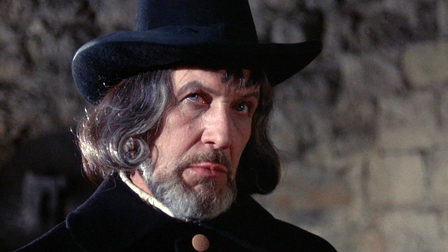
The intimidating Witchfinder General is a horror show about a witch-burning charlatan during a time of civil war in England. Quickly gaining a reputation for violence, the film was released in America as The Conqueror Worm, using a flimsy excuse to brand it as yet another Poe adaptation. I remember seeing it billed quite a bit with biker films; A.I.P. apparently decided that the two audiences were congruent. Some time in the 1970s Witchfinder gathered a cult reputation centered on the (then) mysterious death of its director. The very young Michael Reeves had directed a couple of promising horror offerings, and Witchfinder was to be his breakout picture. An acolyte of director Don Siegel and a worshipper of Sam Peckinpah, Reeves fielded the aggressive defense that his movie was superior because it offered an intelligent examination of the way violence begets violence, until it becomes an end in itself.
King's officer Richard Marshall (Ian Ogilvy) and his beloved Sara (Hilary Dwyer) see their happy life ruined when her father, a pastor, is denounced, tortured and executed. The villain is Matthew Hopkins (Price), a roving, predatory opportunist who travels from town to town with his thug-lackey John Stearne (Robert Russell), charging local magistrates to rid their parishes of witches. If prospective victims have attractive wives or daughters, the vile Hopkins avails himself of the opportunity to bed them with false promises of leniency. Cold and relentless, the hypocrite Hopkins victimizes old women and is quick to arrest those that dare denounce him. To obtain confessions, Stearne uses a spike to "probe for the devil's spot." Catch-22 word games insure that both a confession and a refusal to confess are interpreted as guilt. The screaming victims are at first dispatched by drowning and hanging, until Hopkins tries out the new continental method of burning on a pyre.
Giving a humorless, hard-as-nails performance, Vincent Price makes Hopkins a cynical monster that profits by twisting the law and exploiting prejudice and fear. The pious and ignorant rural populace accepts the intolerable torment he inflicts. Director Reeves and his supporters claim that by going to such extremes, the film presents a coherent thesis on the nature of violence. In his righteous vengeance the hero becomes as equally distorted as Hopkins himself. By the finale, Richard Marshall's desire to slaughter Hopkins has become so acute that he forgets all about comforting Sara, the woman he wants to save.
Michael Reeves' argument may have been dubious. But his direction is better than good, particularly given the fact that he accomplishes a period drama on a relatively miniscule budget. On a first viewing the film builds terrific tension, and seems much more violent than it really is. If the aim is to sicken the viewer so that the final burst of carnage becomes repulsive, the film is a big success. I've read reviews by critics so disturbed by the ending that they reported that Ian Ogilvy gives a corpse a seemingly unending series of axe blows. That just isn't the case.
Fans and critics have championed Reeves as the "James Dean" of young directors, who had he lived might have made terrific horror films. A sort of self-taught child prodigy who jump-started his career when still almost a teenager, Reeves died before fully indicating his career goals. It's altogether possible that he might have ditched the horror genre as soon as possible, to make films like those of his idol, Don Siegel. Everything remains at the level of conjecture -- we'll never know how good he might have been.
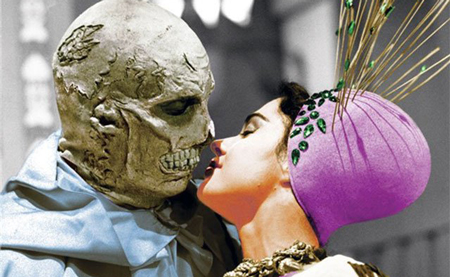
The final film The Abominable Dr. Phibes is perhaps Vincent Price's strongest departure from the Poe mold. A definite attempt to initiate a new series of horror thrillers, it's the brainchild of Robert Fuest, a director at the time best known for episodes of the Brit TV show The Avengers. He'd already been tapped by A.I.P. for the straight gothic romance Wuthering Heights, which provided an important early role for Timothy Dalton. Often praised for its ornate art direction, Dr. Phibes is a macabre, fantastic murder tale in a 1920s period setting. The Art Deco sets and vintage music are given equal emphasis with the episodic storyline.
Like Gaston Leroux's Phantom of the Opera, the crazed Dr. Phibes (Vincent Price) lives in a palatial subterranean lair ballroom, albeit with a very un-Phantom-ish flair for interior decoration. A band of mechanical musicians plays foxtrots when Phibes isn't blowing out the walls with his thunderous pipe organ. But there's no audience in sight for the stylish concerts, or the ritualized entrances and exits of Phibes' exquisitely costumed assistant-henchwoman Vulnavia (Virginia North). The symmetrical compositions and sumptuous colors are all show for the camera. Happily enough, Fuest makes his film self-aware without being overly Camp. He goes easy on the pulp atmosphere as well. Vulnavia will enter a scene, and pause briefly to look at the camera before continuing -- a slight "wink" effect that further suggests a lavish illustration come to life.
For once the plot mechanics are halfway interesting... for a movie that must invent multiple novel ways to commit murders. Believed killed in a car crash, Dr. Phibes is wreaking a ridiculously elaborate vengeance on the nine doctors he thinks have murdered his wife (Caroline Munro in a non-speaking, non-living, uncredited appearance). To kill them he uses the nine plagues of Egypt made familiar from C.B. DeMille's The Ten Commandments -- locusts, bats, blood, toads, etc.. The Head Surgeon Dr. Vesalius (Joseph Cotten) receives the curse visited by Moses on Yul Brynner's Pharaoh: Phibes puts his first-born son in a horrible Saw- like trap.
Director Fuest succeeded in making his the first name that comes up when discussing Phibes. The look of the picture is everything, and plot specifics limit Price's involvement. In fact, we wonder if the project is a waste of his talents. Reduced by fire to a grinning skull, Phibes uses makeup appliances to appear human, pasting on ears, a nose, etc. Price mimes a number of expressive moments, but his face always wears one immobile expression. Even stranger, for the most part Phibes can't talk. He does speak a bit through a voice machine tapped into his neck, but it's clear that his part was post-dubbed, literally phoned-in. Fuest purposely strips Price of everything but his steely stare. No wonder that the critical praise for Dr. Phibes focuses on the film's lush look.
Fuest does exhibit a knack for handsome camera angles, which puts him far ahead of most A.I.P. and Hammer directors of the time. He shoots scenes as masters and not standard coverage, and moves the camera to keep the screen energized. Although the various murders are neatly sketched, the visual inspiration doesn't extend to the storytelling aspect. The killings plod along, with the befuddled Inspector Trout (Peter Jeffrey) only partly winning our affection. Attempts at humor aren't particularly successful. Price of course remains a deadpan presence throughout, at the most rolling his eyes once or twice to indicate satisfaction with his murderous ingenuity.
The Special Guest Victims probably did at most a half-day's work each. Terry Thomas is so likeable a presence that we're sad to see him exit so quickly. As a rabbinical scholar, Hugh Griffith spells out the Biblical curse angle. Antique cars and a vintage biplane are nicely used; Phibes has no spectacular scenes with large crowds but never seems claustrophobic. Helping considerably is a selection of pop songs on the soundtrack, including jazz standards. Several are wildly anachronistic, but then again so is much of the furniture in Fuest's Art Deco sets. The Abominable Dr. Phibes has its own special little vibe going, so much so that a charming scene can consist simply of Phibes asking Vulnavia to dance in their private nightclub setting.
The film was set up for an immediate sequel, which indeed went straight into production. Robert Fuest continued on to the ambitious, overreaching The Final Programme and then on to The Devil's Rain, which pretty much brought his feature directing days to an end. But The Abominable Dr. Phibes remains a favored title among Price fans.
Scream (Shout!) Factory's Blu-ray of The Vincent Price Collection was a guaranteed Christmas gift winner and can be counted as one of the most desirable of recently released classic horror Blu-rays. All of the transfers are excellent; MGM's remastering of the titles is exemplary.
Fans of The Masque of the Red Death have noted that couple of brief snippets that appeared on a 1990s laserdisc are not present. I have the full story on this issue. These shots were censorship trims requested by the Legion of Decency back in 1964 and were not part of the original American release. The cuts were made to the original negative, and thus absent when MGM struck a new interpositive for their transfer. In addition to the censorship trims, two short scenes were removed from the U.S. release but kept in the U.K. version.
Otherwise the only other version variation occurs on Witchfinder General. A couple of alternate takes with topless bargirls were used to fill out the U.S. "R" rating in the U.S.. These were shot by producer Tony Tenser against the wishes of director Reeves and are not missed. Scream Factory does include as an extra the alternate Conqueror Worm opening and closing with Vincent Price reciting a few lines of Edgar Allan's poem. The silly TV prologue added to pad out Pit and the Pendulum is here; it at least gives us an opportunity to see more of Luana Anders.
A nice touch on all the pictures save Phibes are Intro and Farewell bookends by Vincent Price, produced by an Iowa PBS station for a film retrospective. They're quite old and the video quality is not the best, but our hero Vincent gives them his full attention. Phibes carries a pleasant interview with a fellow behind the making of the clever (and smartly written) little blackout sketches.
Each show comes with a trailer and a still gallery. Quite a few of the extras have been repurposed from older MGM "Midnite Movies" DVD discs.Ten years ago MGM went all-out to document the strange history of Witchfinder General, and the commentary they produced with producer Philip Waddilove and actor Ian Ogilvy is exceptionally good. Roger Corman lends his personal memories to Usher, Pit, Palace and Masque. Three new commentaries gather a knowledgeable group of pro writers. Price biographer Lucy Chase Williams, ace genre chronicler Tom Weaver and the highly informed Steve Haberman cover Usher, Palace and Masque with pertinent facts, observations and opinions. Also, author Justin Humphreys and the late director Robert Fuest share their thoughts on Dr. Phibes.
Of special mention are older interviews with Vincent Price, conducted by David Del Valle. An audio piece shows up on Usher and a longer 1987 interview has been placed on the Witchfinder disc. Del Valle's overview essay of Price's career appears in an insert pamphlet, along with poster images and color stills from all the movies.
Here's hoping that the reception of The Vincent Price Collection encourages Scream Factory into continuing with the Vincent Price saga -- still to go are the official Corman-Poe Tales of Terror, The Raven and The Tomb of Ligeia. If one is willing to toss the net a little wider, there's also the Price pictures The Comedy of Terrors, Tower of London, Twice-Told Tales and perhaps The Last Man on Earth. Perhaps if it's called "The Roger Corman Collection", the disc set could contain hotter non-Price items like X - The Man with X-Ray Eyes and The Premature Burial.
On a scale of Excellent, Good, Fair, and Poor,
The Vincent Price Collection Blu-ray rates:
Movie: Usher, Pit, Masque, Witchfinder Excellent;Palace, Phibes Very Good.
Video: All Very Good - Excellent
Sound: All Very Good - Excellent
Supplements: many -- see above
Deaf and Hearing-impaired Friendly?
YES; Subtitles: English
Packaging: Three discs in card and plastic disc holder in card sleeve
Reviewed: February 2, 2014

Text © Copyright 2014 Glenn Erickson
See more exclusive reviews on the Savant Main Page.
The version of this review on the Savant main site has additional images, footnotes and credits information, and may be updated and annotated with reader input and graphics.
Return to Top of Page
|

